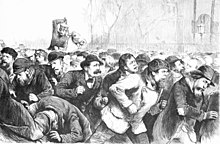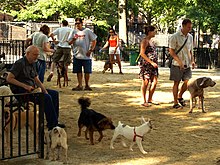Tompkins Square Park
The Tompkins Square Park is a square, 4.2 hectares large public park in the Alphabet City of the East Village in the district of Manhattan in New York City . One of the distinctive features of Tompkins Square Park is its population of American elms (Ulmus americana).
location
The park is bounded on the north by East 10th Street, on the east by Avenue B , on the south by the East 7th Street and on the west by Avenue A . St. Mark's Place borders the park to the west.
history
19th century
Where Tompkins Square Park is now, there used to be a salt marsh that was inundated by the East River at high tide and was formerly called Stuyvesant Meadows before it was filled.
The undeveloped marshland , like most agricultural land, was hardly taxed by the city and seemed of little value to its owners, the descendants of Petrus Stuyvesant . One of them, Peter Gerard Stuyvesant (1778–1847), donated part of it to the city in 1829 with the agreement that it should become a public space. The city compensated other landowners and converted the muddy land into building land. Five years later, Tompkins Square was opened in 1834. In the following year it was bordered with a cast iron fence and planted with trees. It was assumed that the square had a prosperous future, but this was delayed by the economic crisis of 1837, which stalled expansion of the city.
Tompkins Square Park was named after Daniel D. Tompkins (1774-1825), who was Governor of New York from 1807 to 1817 and then Vice President of the United States under President James Monroe . During his tenure as governor, he oversaw some early drainage works in the area that were carried out in conjunction with minor fortifications during the British-American War of 1812 .
The park opened in 1850.
Up until the 20th century, the square also served as a parade ground for the New York National Guard . When immigrants protested here in 1857 because of unemployment and food ration cuts, they were attacked by the police. In 1863 the park was the site of the deadly Draft Riots .
On January 13, 1874, the Tompkins Square riot occurred in the park, during which police beat down a demonstration of thousands of workers. These riots marked an unprecedented era of workers' uprisings and violence. 1877, 5,000 people gave a battle with the National Guard, as they gathered, was a communist , revolutionary to hear speech.
In April 1897, a rabbi was arrested who did not have permission to perform a birkat ha-Chama , a Jewish ritual that is only performed every 28 years.
20th century
Tompkins Square lost the character of a parade ground when it was given a modern design by Robert Moses in 1936. It is said that the aim was to better divide and get a grip on the mass gatherings that have gathered here for protests since the 1870s. This tradition revived in the 1960s when the park became the home of demonstrations against the Vietnam War .
By the 1980s, Tompkins Square Park had become synonymous with the city's growing social problems for many New Yorkers . The park had a high crime rate , homeless camps, and was a hub for illegal drugs. Heroin addicts put their syringes here.
When police tried to clear the park's homeless camps in August 1988, a riot broke out in which 44 people were injured. Bystanders, as well as the homeless and political activists, were drawn into the police action that took place on the night of August 6th and 7th after a large number of police officers surrounded the park and attacked the trapped crowd while other police officers instructed all pedestrians to Avoid the streets around the park. Much of the violence was filmed by video cameras and featured on local television news. Including a sequence in which a man who was sitting on the steps of his house continued to film while he was being beaten by a police officer. Ultimately, only one case went to court, but no police officer was found guilty.
From June 3, 1991 to July 25, 1992, the park was closed to the public due to renovation measures - also to keep the homeless away and to calm the existing tensions.
The Tompkins Square Dog Run is the result of an initiative that was founded in the mid-1980s by dog owners who, despite the difficult conditions in the park (crime, drug abuse), did not want to do without a place where their dogs can get their exercise. Because of their commitment, the first dog run in New York was opened in Tompkins Square Park. Mainly because of the very limited living space and the otherwise strict leash requirement, many of the approximately 1,000,000 dog owners from all walks of life use the dog runs in Manhattan. As part of the renovation and upgrading of the park, the city's largest dog run since then was opened here in 1990, which has recently been refurbished for $ 450,000, which was raised on the one hand by the city and on the other through donations and fundraising . Today the Dog Run has a sandy area, three swimming pools, picnic tables and bathing facilities as well as water hoses to shower the dogs. For example, the Halloween party of the dog run area raised money for the rehabilitation of the dog run. It is the largest canine Halloween party in the United States , featuring over 400 costumed dogs annually and attracting approximately 2,000 onlookers.
21st century
After its redevelopment in the early 1990s, the East Village began to become increasingly gentrified . At the same time, a curfew for the park was enforced and homeless people were expelled from the park. This changed the character of Tompkins Square Park noticeably.
Today the park offers playgrounds , basketball and handball courts , tables for chess players and a dog run. It has become a popular place for young families, students and the elderly, and attracts tourists from all over the world.
Events

The open-air drag festival "Wigstock" takes place in the park and is now part of the Howl Festival . The Carlie Parker Jazz Festival is a musical tribute to the famous jazz legend who lived on Avenue B. In 2007 the New Village Music Festival was launched to celebrate New York's diverse music scene.
Every summer there is a "Riot Reunion" concert called "Cracktöberfest", at which the punk band of the district - Leftöver Crack - performs or one of their other formations such as Choking Victim or Star Fucking Hipsters .
The Food Not Bombs Manhattans branch offers free meals every Sunday regardless of the weather. The Cultural Department of the French Embassy in the United States in New York and the New York City Department of Parks and Recreation are jointly hosting a popular free French film festival that shows acclaimed French films every Friday after sunset in urban parks in June and July - including also Tompkins Square Park.
Monuments
The Hare Krishna tree - a particular elm that stands next to benches arranged in a semicircle - is sacred to followers of the Hare Krishna movement, as AC Bhaktivedanta Swami Prabhupada sang the Hare Krishna mantra for the first time outside of India under this tree . He was the founder of the International Society for Krishna Consciousness . Participants in this ceremony included the poet of the Beat Generation Allen Ginsberg . This event is considered to be the establishment of the Hare Krishna religion in the United States. The tree is therefore respected by Krishna followers as an important religious site.
The memorial on the north side of the park commemorates the General Slocum ship disaster of June 15, 1904, in which over 1,000 people were killed - mainly women and children of German immigrants who drowned in the East River that day. There was great sadness in the area around the park, which was formerly known as Kleindeutschland . This disaster is also commemorated in James Joyce's novel Ulysses .
In the southwest corner of the park is a statue of Samuel S. Cox (1824-1889), a New York politician who sat in the United States House of Representatives for Ohio and New York , among other things .
Individual evidence
- ↑ Eric W. Sanderson, Mannahatta: A Natural History of New York City , 2009: map p. 127.
- ^ Hassell, Malve Von Hassell: Homesteading in New York City, 1978-1993: The Divided Heart of Loisaida . Bergin & Garvey, 1996, p. 39.
- ^ Edwin G. Burrows and Mike Wallace, Gotham: A History of New York City to 1898 , 1999: 579
- ^ Carolyn Ratcliffe (Lower East Side Preservation Institute) "The thin green line: a timeline of the Lower East Side —Tompkins Square area"
- ↑ a b c John Strausbaugh: Paths of Resistance in the East Village . In: The New York Times , September 14, 2007. Retrieved August 25, 2008.
- ^ Gordon, Michael Allen: The Orange Riots: Irish Political Violence in New York City, 1870-1871 . Cornell University Press, 1993, p. 203.
- ↑ Hebrew Festival Marred . In: The New York Times , April 8, 1897. Retrieved March 5, 2010.
- ^ Hassell, Malve Von Hassell: Homesteading in New York City, 1978-1993: The Divided Heart of Loisaida . Bergin & Garvey, 1996, p. 44.
- ↑ Dog Run Culture , Jesse McKinley, The New York Times , October 15, 1995; accessed August 15, 2008.
- ↑ a b Dog run history
- ^ Films on the Green . Retrieved July 12, 2009.
- ^ Films on the Green: Claire's Knee . Retrieved July 12, 2009.
Web links
- Information about Tompkins Square Park on the homepage of the New York City Department of Parks and Recreation (English)
- Article "Letter from Tompkins Square Park" (English)
- The Story of the Tompkins Square Police Riot - from the archives of WBAI radio
- Howl Festival (English)
- Tompkins Square Dog Run / First Run (English)
- Stranger to The System: Life Portraits of a New York City Homeless Community, webpage for a documentary chronicling the lives of twenty people living in Tompkins Square
- Area map of Tompkins Square Park: MondoMap
- Tompkins Square Park on "On The Inside"
Coordinates: 40 ° 43 ′ 34.4 " N , 73 ° 58 ′ 54.8" W.





